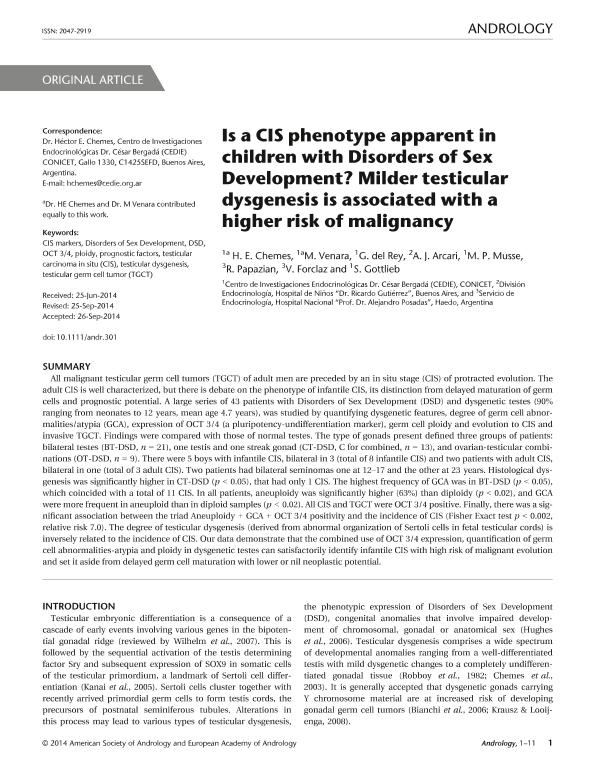Artículo
Is a CIS phenotype apparent in children with Disorders of Sex Development? Milder testicular dysgenesis is associated with a higher risk of malignancy
Chemes, Hector Edgardo ; Venara, Marcela Cristina
; Venara, Marcela Cristina ; del Rey, Graciela Monica
; del Rey, Graciela Monica ; Arcari, A. J.; Musse, Mariana Paula
; Arcari, A. J.; Musse, Mariana Paula ; Papazian, R.; Forclaz, V.; Gottlieb, Silvia Elisa
; Papazian, R.; Forclaz, V.; Gottlieb, Silvia Elisa
 ; Venara, Marcela Cristina
; Venara, Marcela Cristina ; del Rey, Graciela Monica
; del Rey, Graciela Monica ; Arcari, A. J.; Musse, Mariana Paula
; Arcari, A. J.; Musse, Mariana Paula ; Papazian, R.; Forclaz, V.; Gottlieb, Silvia Elisa
; Papazian, R.; Forclaz, V.; Gottlieb, Silvia Elisa
Fecha de publicación:
09/2014
Editorial:
Wiley
Revista:
Andrology
ISSN:
2047-2919
Idioma:
Inglés
Tipo de recurso:
Artículo publicado
Clasificación temática:
Resumen
All malignant testicular germ cell tumors (TGCT) of adult men are preceded by an in situ stage (CIS) of protracted evolution. Theadult CIS is well characterized, but there is debate on the phenotype of infantile CIS, its distinction from delayed maturation of germcells and prognostic potential. A large series of 43 patients with Disorders of Sex Development (DSD) and dysgenetic testes (90%ranging from neonates to 12 years, mean age 4.7 years), was studied by quantifying dysgenetic features, degree of germ cell abnormalities/atypia (GCA), expression of OCT 3/4 (a pluripotency-undifferentiation marker), germ cell ploidy and evolution to CIS andinvasive TGCT. Findings were compared with those of normal testes. The type of gonads present defined three groups of patients:bilateral testes (BT-DSD, n = 21), one testis and one streak gonad (CT-DSD, C for combined, n = 13), and ovarian-testicular combinations(OT-DSD, n = 9). There were 5 boys with infantile CIS, bilateral in 3 (total of 8 infantile CIS) and two patients with adult CIS,bilateral in one (total of 3 adult CIS). Two patients had bilateral seminomas one at 12?17 and the other at 23 years. Histological dysgenesiswas significantly higher in CT-DSD (p < 0.05), that had only 1 CIS. The highest frequency of GCA was in BT-DSD (p < 0.05),which coincided with a total of 11CIS + Seminomas. In all patients, aneuploidy was significantly higher (63%) than diploidy(p < 0.02), and GCA were more frequent in aneuploid than in diploid samples (p < 0.02). All CIS and TGCT were OCT 3/4 positive.Finally, there was a significant association between the triad Aneuploidy + GCA + OCT 3/4 positivity and the incidence of CIS (FisherExact test p < 0.002, relative risk 7.0). The degree of testicular dysgenesis (derived from abnormal organization of Sertoli cells in fetaltesticular cords) is inversely related to the incidence of CIS. Our data demonstrate that the combined use of OCT 3/4 expression,quantification of germ cell abnormalities-atypia and ploidy in dysgenetic testes can satisfactorily identify infantile CIS with high riskof malignant evolution and set it aside from delayed germ cell maturation with lower or nil neoplastic potential.
Archivos asociados
Licencia
Identificadores
Colecciones
Articulos(CEDIE)
Articulos de CENTRO DE INVESTIGACIONES ENDOCRINOLOGICAS "DR. CESAR BERGADA"
Articulos de CENTRO DE INVESTIGACIONES ENDOCRINOLOGICAS "DR. CESAR BERGADA"
Citación
Chemes, Hector Edgardo; Venara, Marcela Cristina; del Rey, Graciela Monica; Arcari, A. J.; Musse, Mariana Paula; et al.; Is a CIS phenotype apparent in children with Disorders of Sex Development? Milder testicular dysgenesis is associated with a higher risk of malignancy; Wiley; Andrology; 3; 1; 9-2014; 59-69
Compartir
Altmétricas



